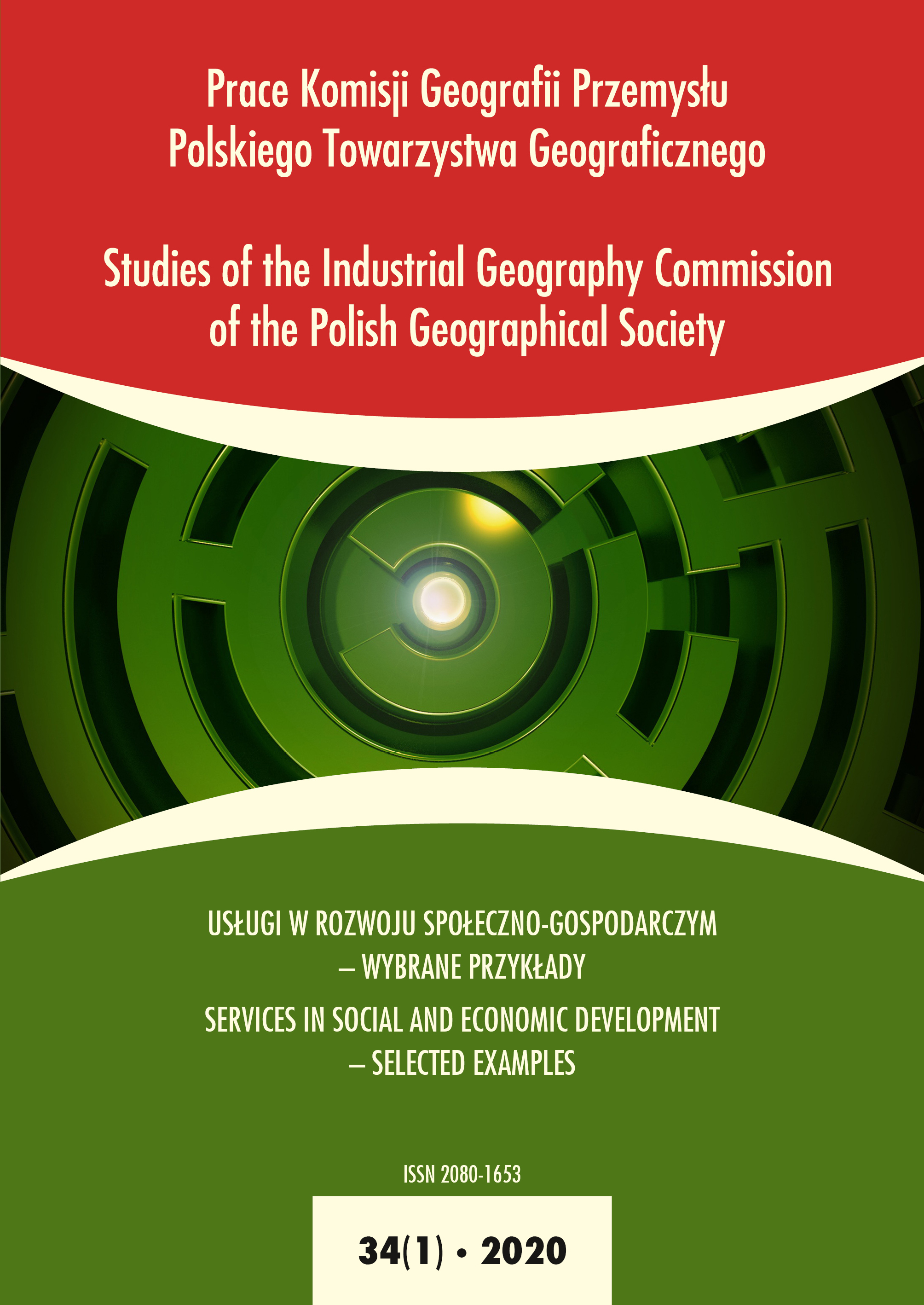Classification of European Union Countries Based on Employment Structure in Sectors and Selected Sections – Assessment of Similarity of Divisions
DOI:
https://doi.org/10.24917/20801653.341.1Keywords:
employment, EU countries, European Union, sectionsAbstract
The aim of the paper is to analyse and evaluate the relation between sector employment structure (sectors are as follows: 1. Agriculture, forestry and fishing; mining and quarrying; 2. Manufacturing; 3. Electricity, gas, steam and air conditioning supply; water supply and construction; 4. Services) and employment structure at selected high technology and knowledge-intensive employment sections in European Union countries. Complete linkage method was used to cluster countries characterised by sector and section employment structures separately, for sector and section structures, and for 2008 and 2018. Respectively 8 and 6 groups of countries in those years have been found with respect to sector structure, while 8 and 9 for high technology and knowledge-intensive sections. Divisions have been compared with Sokołowski’s (1976) measure similar to Rand index. The results are as follows: sector structures between 2008 and 2018 - 0.839; section structures between 2008 and 2018 - 0.913; between sector and section structures in 2008 - 0.704; between sector and section structures in 2018 - 0.807.
Downloads
Metrics
References
Chomątowski, S., Sokołowski, A. (1978). Taksonomia struktur. Przegląd Statystyczny, 2, 217–225.
Eurostat (2019, 25 września). Pozyskano z htec_emp_reg2, http://appsso.eurostat.ec.europa.eu/nui/show.do?dataset=htec_emp_reg2&lang=en
Markowska, M. (2016). Identyfikacja znaczenia krajów w gospodarce Unii Europejskiej z wykorzystaniem miary dekompozycji zmian struktury. Zeszyty Naukowe Uniwersytetu Ekonomicznego w Krakowie, 9(957), 71–87.
Markowska, M. (2017a). Decomposition of changes in structure and trends in employment in Czechia at NUTS 2 level. GeoScape, 11(2), 84–92.
Markowska, M. (2017b). Province capitals vs. their neighbors – the assessment of changes by dynamic classification of employment structures. Studia Ekonomiczne. Zeszyty Naukowe Uniwersytetu Ekonomicznego w Katowicach, 314, 28–44.
Markowska, M., Sobolewski, M. (2014). Wrażliwość regionalnych rynków pracy Unii Europejskiej na kryzys ekonomiczny. Klasyfikacja metodą Warda z warunkiem spójności. Acta Universitatis Lodziensis. Folia Oeconomica, 308, 87–103.
Markowska, M., Sobolewski, M., Sokołowski, A., Strahl, D. (2014). Tests for connection between clustering of polish counties and province structure. Statistics in Transition. New Series, 15(2), 309–316.
Markowska, M., Sokołowski, A. (2016). Metoda dekompozycji zmian struktury. Prace Komisji Geografii Przemysłu Polskiego Towarzystwa Geograficznego, 30(3), 25–32.
Markowska, M., Sokołowski, A. (2017). Ocena udziału sektorów w zróżnicowaniu struktur zatrudnienia w Warszawie i powiatach sąsiadujących w latach 2005–2014. Prace Komisji Geografii Przemysłu Polskiego Towarzystwa Geograficznego, 31(4), 25–39.
Markowska, M., Sokołowski, A. (2019). Sektorowe struktury zatrudnienia w krajach Unii Europejskiej w latach 2008–2017 – nowe podejście w ocenie dynamiki. Prace Komisji Geografii Przemysłu Polskiego Towarzystwa Geograficznego, 33(2), 7–17.
Markowska, M., Sokołowski, A., Strahl, D. (2014). Taksonomia dynamiki zmian struktury zatrudnienia w nowoczesnym przemyśle i usługach, w regionach Unii Europejskiej. Prace Komisji Geografii Przemysłu Polskiego Towarzystwa Geograficznego, 26, 46–64.
Markowska, M., Sokołowski, A., Strahl, D. (2019). Dynamiczne skalowanie wielowymiarowe w analizie zmian struktury zatrudnienia w krajach Unii Europejskiej w latach 1999–2016. Prace Komisji Geografii Przemysłu Polskiego Towarzystwa Geograficznego, 33(1), 7–17.
Markowska, M., Strahl, D. (2017). Miasta wojewódzkie a ich otoczenie – trendy zmian sektorowej struktury pracujących. Prace Naukowe Uniwersytetu Ekonomicznego we Wrocławiu, 477, 135–143.
Markowska, M., Strahl, D., Sobczak, E., Hlavacek, P. (2019). Podobieństwo struktur zatrudnienia w krajach Unii Europejskiej w latach 2008–2017 – ocena dynamiki. Prace Komisji Geografii Przemysłu Polskiego Towarzystwa Geograficznego, 33(4), 283–294.
Najman, K. (2007). Charakterystyka mierników oceny podobieństwa wyników podziałów. Prace i Materiały Wydziału Zarządzania Uniwersytetu Gdańskiego, 3, 191–201.
Rand, W.M. (1971). Objective criteria for the evaluation of clustering methods. Journal of the American Statistical Association, 66(336), 846–850.
Sokołowski, A. (1976, 1977). Metoda porównywania wyników podziału zbioru skończonego. XII Konferencja naukowa ekonometryków, statystyków i matematyków z Akademii Ekonomicznych Katowic, Krakowa i Wrocławia. Karpacz. Streszczenie: Przegląd Statystyczny, 365.
Węgrzyn, G. (2014). Knowledge-intensity and employment structures in European countries. Journal of International Studies, 7(2), 96–105.
Węgrzyn, G. (2015). Innowacje w sektorze usług a zmiany strukturalne w zatrudnieniu. Monografie i Opracowania, 256. Wrocław: Uniwersytet Ekonomiczny we Wrocławiu.
Węgrzyn, G. (2017a). Employment in the Service Sector – Nature of its Structural Changes. W: Hradec Economic Days Vol. 7(1). Double-blind peer-reviewed proceedings of the international scientific conference Hradec Economic Days 2017, January 31 st and February 1 st, Hradec Králové, Czech Republic / Jedlicka Pavel, Maresova Petra, Soukal Ivan (red.), University of Hradec Králové, 926–935.
Węgrzyn, G. (2017b). Pracujący w sektorze usług w gospodarce opartej na wiedzy – zmiany strukturalne. Prace Naukowe Uniwersytetu Ekonomicznego we Wrocławiu, 475, 368–379.
Węgrzyn, G., Miłaszewicz, D. (2017). Sektor usług w gospodarce opartej na wiedzy – analiza porównawcza. Studia i Prace Wydziału Nauk Ekonomicznych i Zarządzania Uniwersytetu Szczecińskiego, 47(3), 433–443.
Downloads
Published
How to Cite
Issue
Section
License
Articles are published under the terms of the Creative Commons License (CC BY-ND 4.0; Attribution– NoDerivs).

